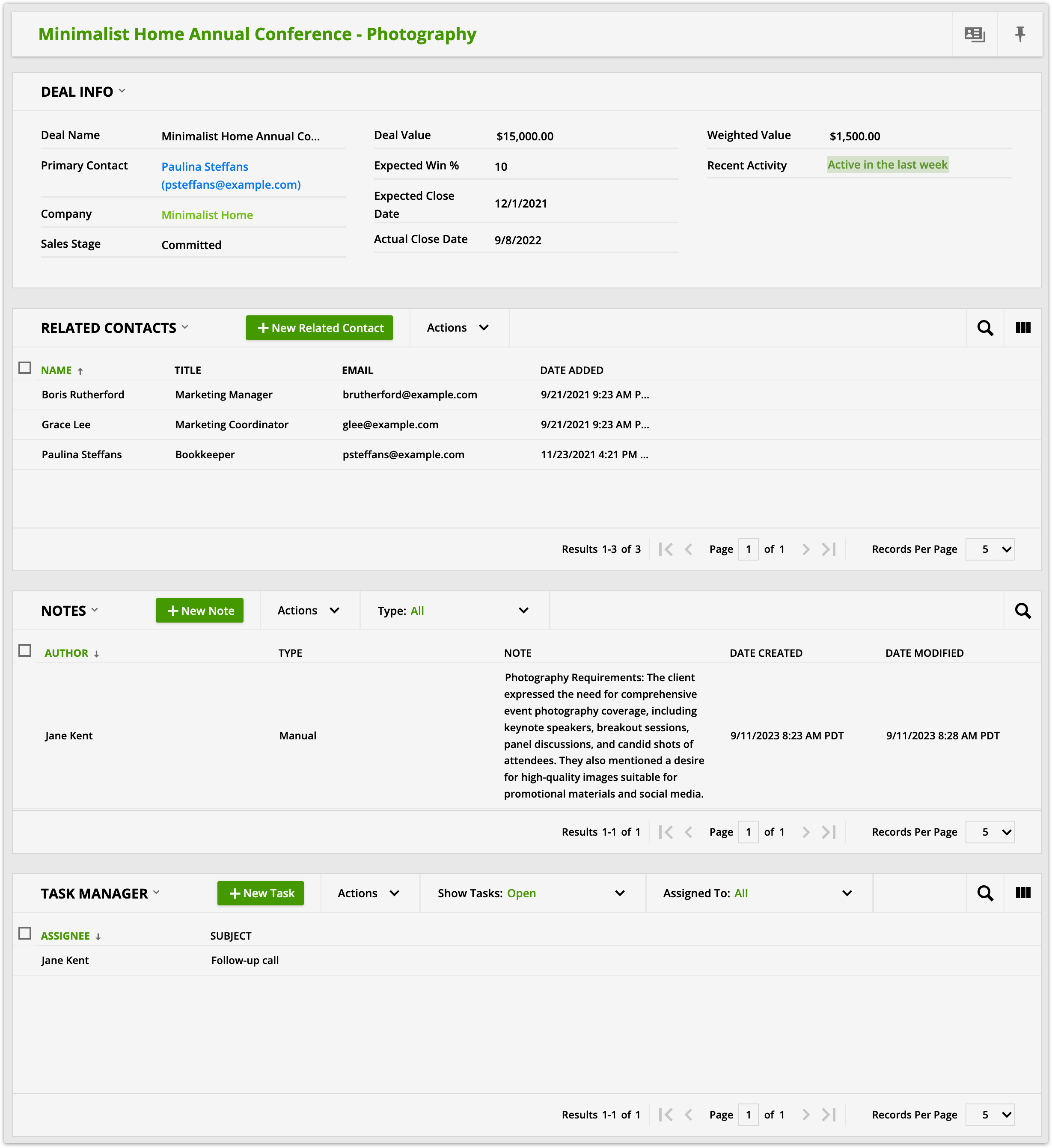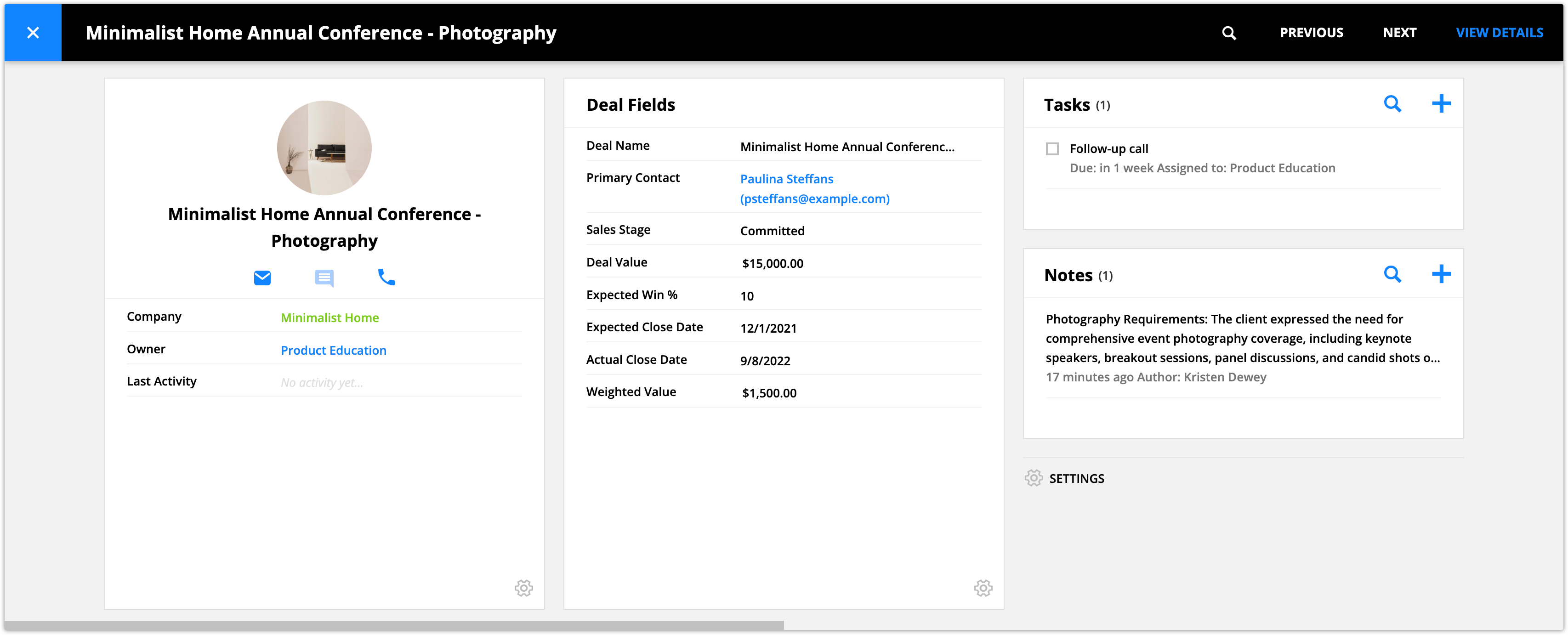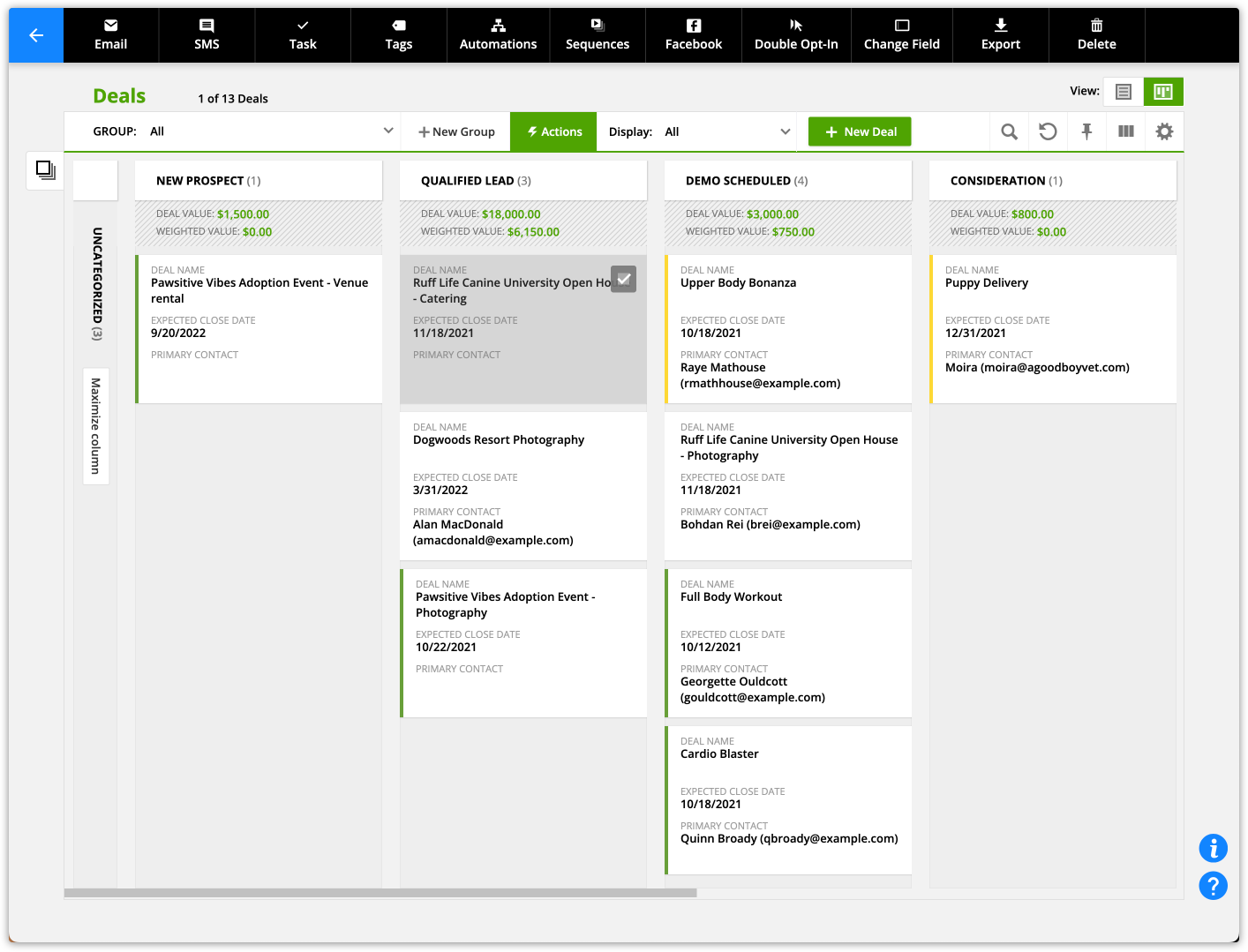It’s critical for salespeople to have a way to monitor potential sales in the pipeline. Deals and Companies allows you to monitor those deals using a pre-configured sales system. These customizable features allow you to:
- visually track deals within your sales stages
- manually and automatically manage follow-up with each deal
- forecast the value of your sales in progress
- and more.
Please note that not all account levels have access to these features. Check out our pricing page to determine if you have access.
Table of contents
How Deals, Companies and Card View work together
Set up Deals and Companies
Manage your sales pipeline using Deals and Companies
About the pre-set framework
• Types of pre-configured automations
Use case
How Deals, Companies and Card View work together
Deal records are created with sales teams in mind and include essential fields such as Deal Value, Expected Win % and automatically calculated Weighted Deal Value. They also include a primary contact for the deal and the associated company.

Companies records include fields such as Industry and Annual Revenue, and they house all the deals and contacts associated with the company for optimal organization.

Card View allows you to view your records by sales stage. The feature comes pre-configured with stages representing a deal’s status as it progresses from New Prospect to Qualified Lead to Closed (Won) and Closed (Lost). Edit or rearrange these stage names to match the terminology your sales team uses.

Sales reps and managers can use group filters to show only deals won in the past seven days or only deals expected to close soon. With this oversight, they can forecast results for budgeting and resource planning.
Object Quick View allows you to view your Deals and Companies records (and any custom object record in your account) without clicking away or loading another screen, making it ideal for managing one-on-one client interactions. You can view your most important client information and interaction history and send messages or log notes quickly and easily through Object Quick View.

You and your sales team can also create groups and choose which fields you want to see to support your workflow. For example, you can create a group of brand new deals that displays the Deal Value field so reps can prioritize calling higher-value businesses.
Set up Deals and Companies
1. Enable Deals and Companies in your account
- Go
.png) to → Apps.
to → Apps. - Toggle on both Deals and Companies.
- Once you have enabled Deals and Companies, they will appear on your account navigation bar.
2. Create a Deal record
- Create a Deal manually by clicking Deals → New Deal on the top navigation bar.
- Create a Deal from a form submission by adding a form to a deal form to a page.
3. Create a Company record
- Create a Company manually by clicking Companies → New Company.
- Create a Company from a form submission by adding a form to a company form to a page.
4. Add a contact to a Company
- Manually add a single contact to a company by clicking Contacts → the name of the contact you want to add → click into the Company field and choose the desired company.
- Add multiple contacts by clicking Contacts →
.png) contacts you want to add → Change Field.
contacts you want to add → Change Field.- Click Select Field → Choose Company.
- Click Select Company → Choose the desired company name to update all selected contacts.
5. Create a Deal connected to a Company record
Because deals are connected to the company that is interested in purchasing, and each deal needs a point of contact, it’s useful to automatically connect all related records to each other. The best way to do this is through a form.
- Click create a deal form on a page.
- Choose your form type.
- Add the following fields: Deal Name, Primary Contact→Email (including first and last name) and Company → Name.
When a form is submitted with Deal, Company and primary contact information, a record for each will be automatically created, and that information will also be added to the Deal record. The record will look like this:
.png)
6. View Deal and Company records as cards in Card View
- Click on Deals or Companies in the main navigation, then click →
.png) .
. - Click
.png) for your Card View settings:
for your Card View settings:- Select a dropdown or color field to display as columns.
- Choose how to sort your cards by selecting from the Sort Cards By dropdown.
- Click Full Card or Mini Card to choose how much information is displayed — Mini Cards will display only three fields.
- Click Add to add fields to your card.
- Select a color field to show on the left of the card. These act as visual cues that help you quickly identify your hottest leads when managing your sales pipeline — Recent Activity is most common.
- Click Save.
- Click
.png) again to get back to List View.
again to get back to List View.
Manage your sales pipeline using Deals and Companies
Once you’ve configured your cards and stages the way you’d like, you can interact with the cards using simple drag-and-drop functionality. Moving a card to a new column updates the related field in the record and can trigger any corresponding automation you’ve set up based on that field update.

You can also easily select certain contacts or groups of contacts and send them an email or SMS, add them to a specific automation map or label them with a particular tag or field value using group actions.

About the pre-set framework
In Card View, both the stages of your pipeline and the fields in deal records are pre-set with the most common and essential fields for sales teams. You can customize them if desired. We’ve also created all the typical automations that sales teams use to keep their pipelines moving, including calculating the expected deal time frame and weighted deal value.
Here’s more information about the pre-configurations.
Types of pre-configured automations
When Deals is activated, Ontraport automatically installs automations that run behind the scenes. The automation maps serve to continually update information in the default fields in Deal records, such as Actual Close Date, Recent Activity and Weighted Value. Based on the updated information, the colors and other visual cues on your cards adjust. Learn more here.
Use case
You can use Deals and Companies for many business types and models. Here’s just one example.
- Let’s say you have a form for people to request a quote from your business. This form has fields for Contact Name, Company and a Deal Name.
- Once submitted, Ontraport creates Contact, Company and Deal records.
- The relationships between the three records are automatically set up. (Note: this form must be created under your Deals object.)
- The form submission also triggers your automation. The deal’s Sales Stage field updates to equal New Prospect.
- In Card View, you can see this new quote request under the New Prospect column.
- A new deal appears in the New Prospect area of your Card View, so you reach out to the deal’s primary contact. Based on this conversation, you learn that this is a qualified lead.
- In Card View, you drag the deal from the New Prospect column to Qualified Lead. This updates the sales stage field in the Deal record.
- You then update the Deal record with the expected value of this project.
- Given that about 75% of similar deals are won in your company, update the weighted deal value to 75%.
- Updating these values kicks off the Calculate Weighted Value automation map. This updates the field for Weighted Value based upon the expected win % and the deal value.
Using this workflow, your sales team can prioritize which qualified leads should be contacted next, and make informed decisions based on projected revenue.
